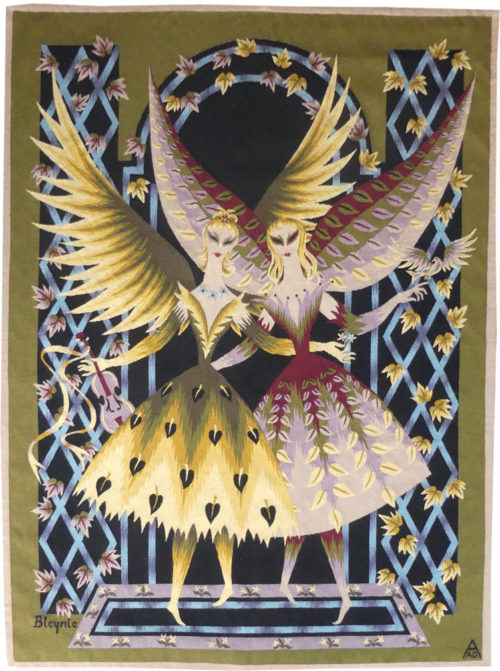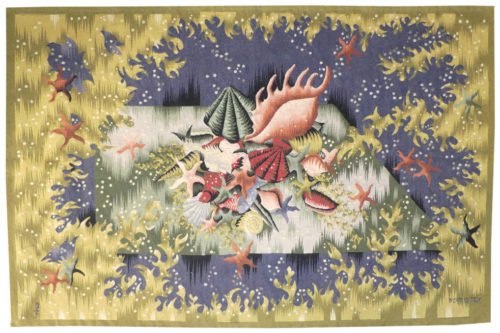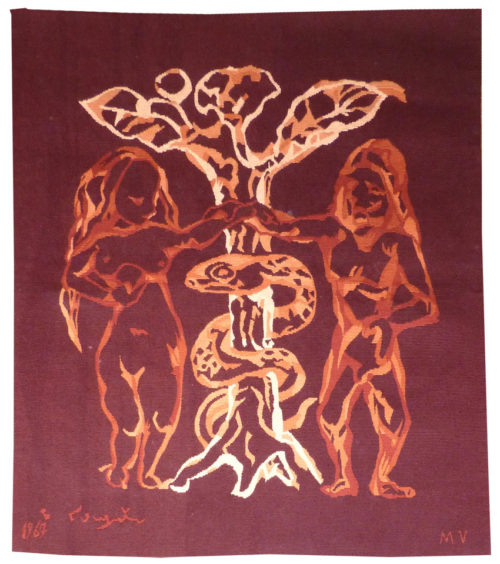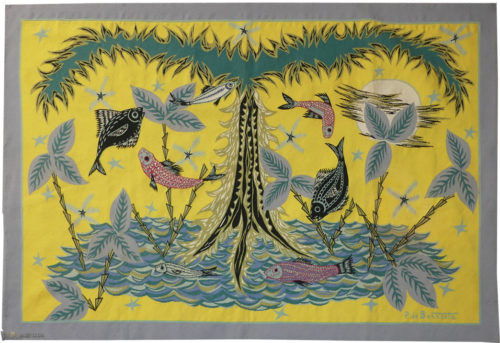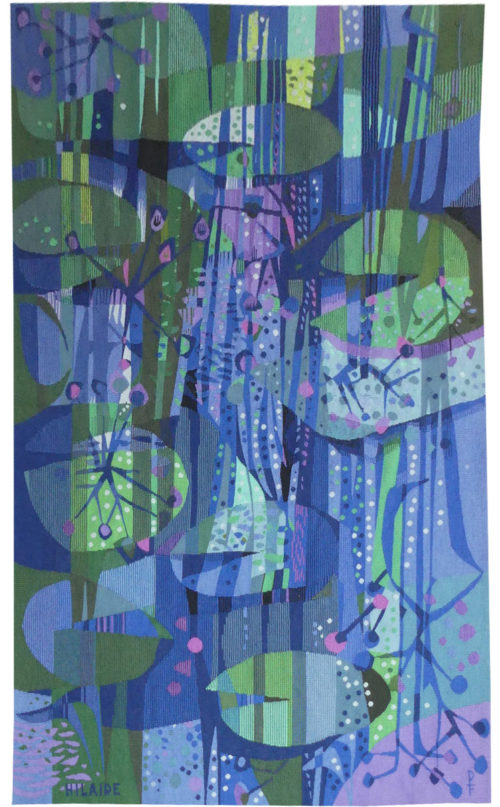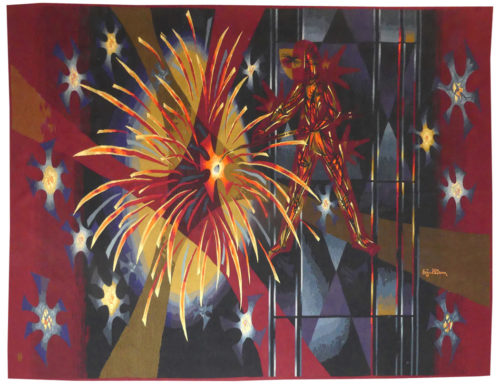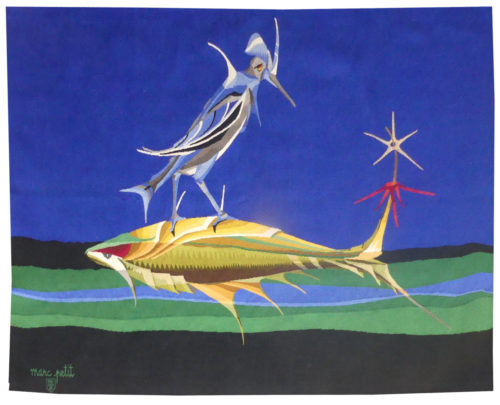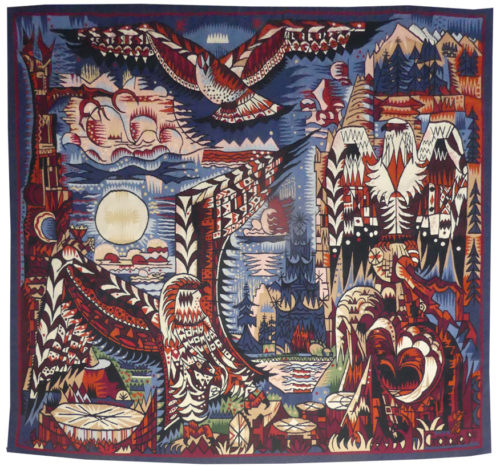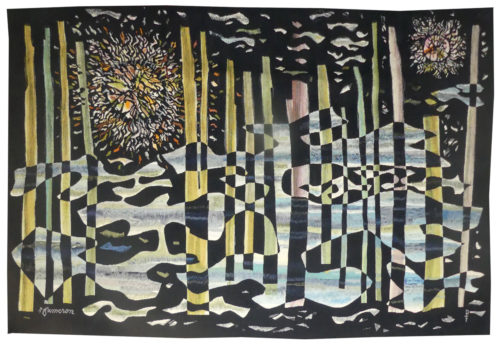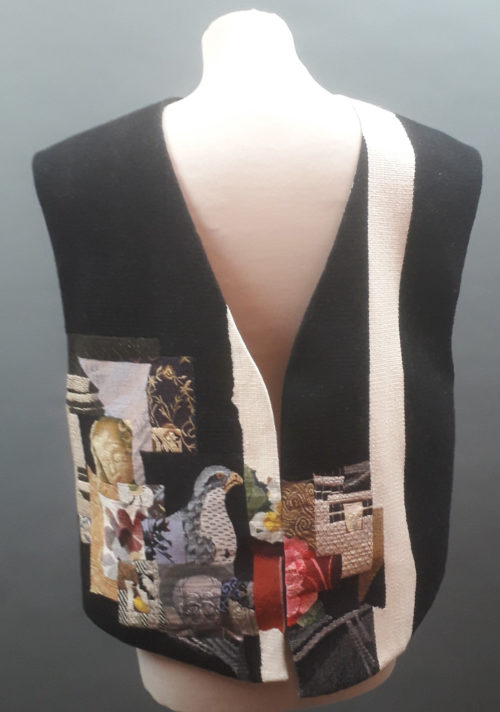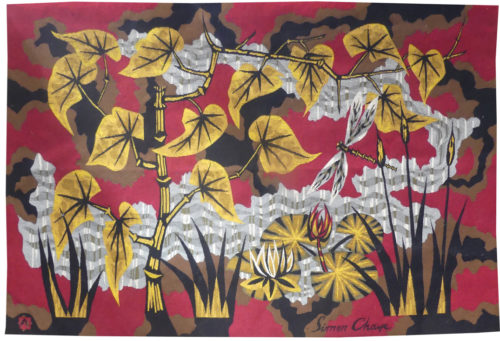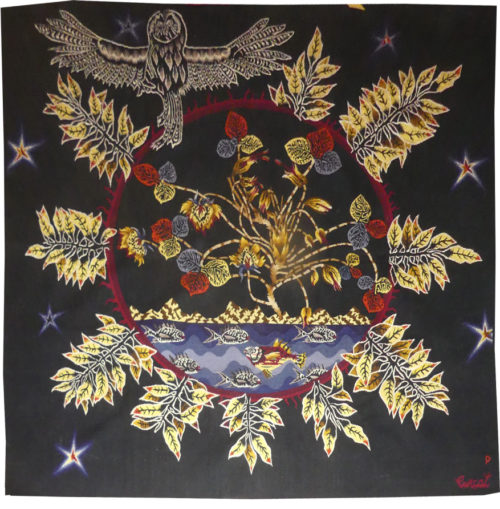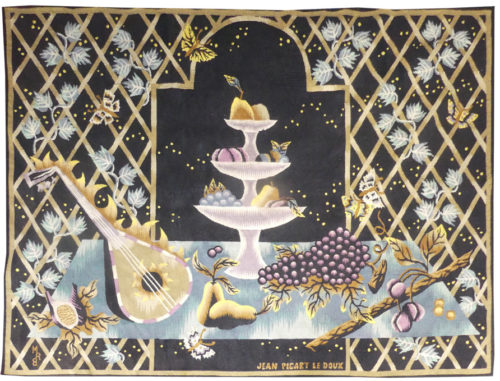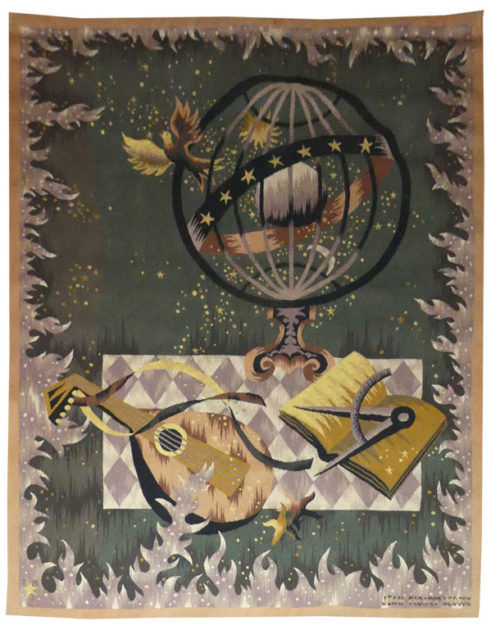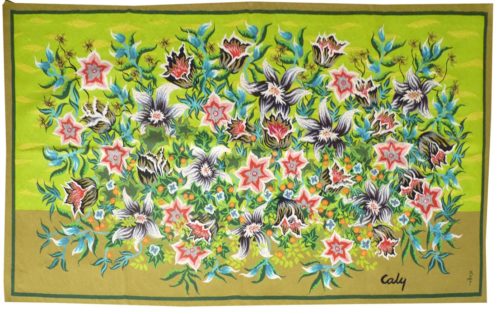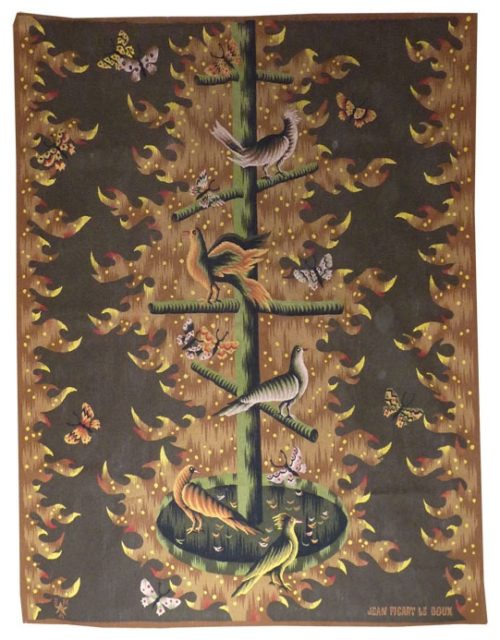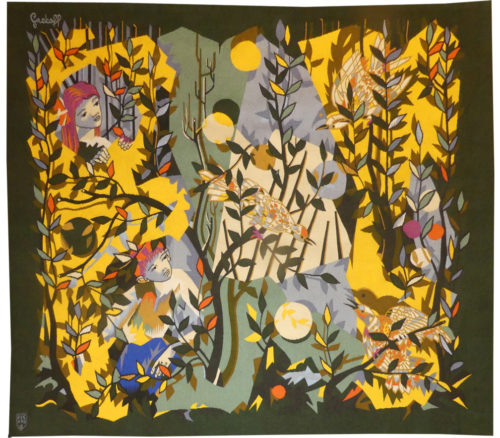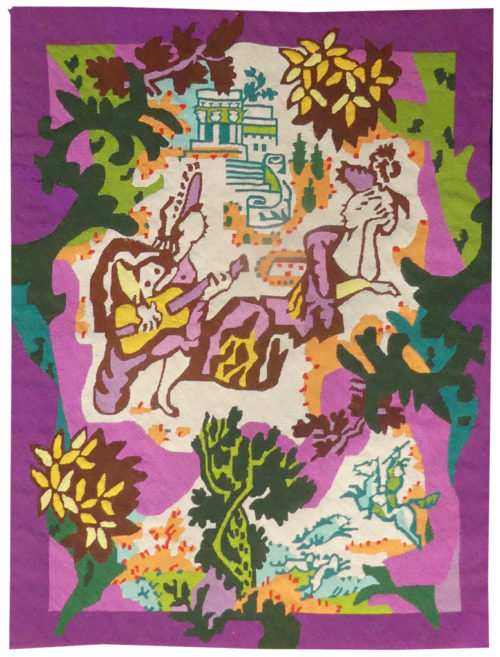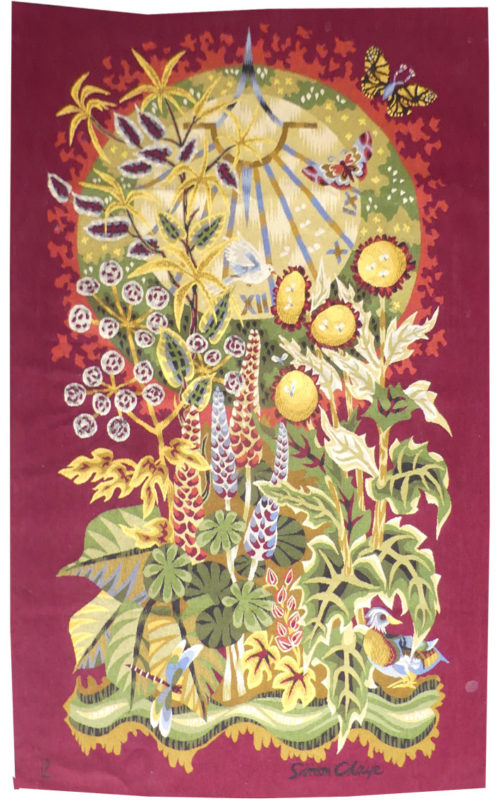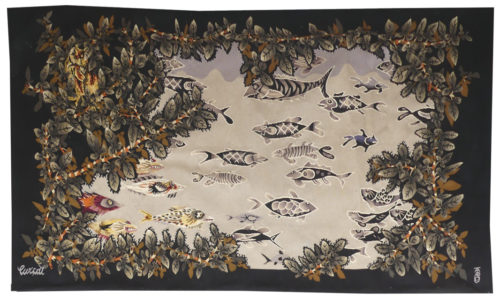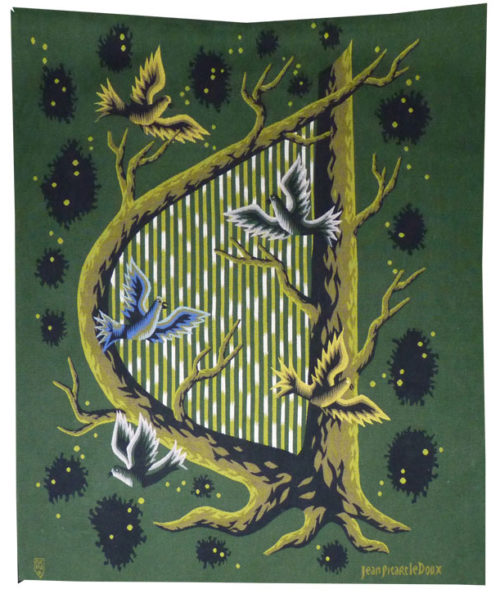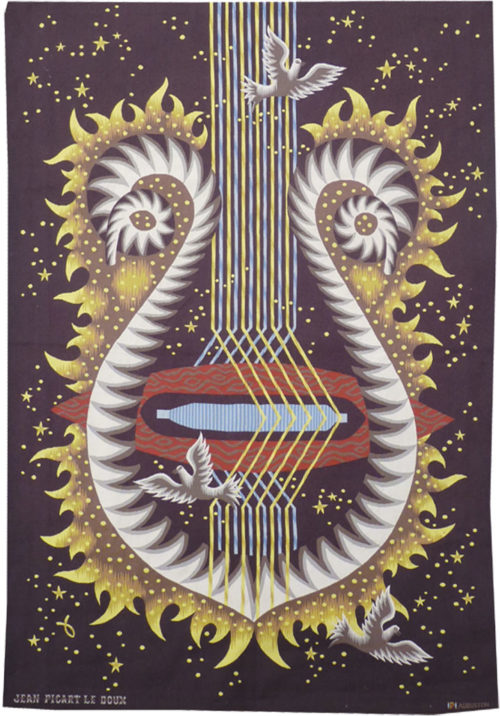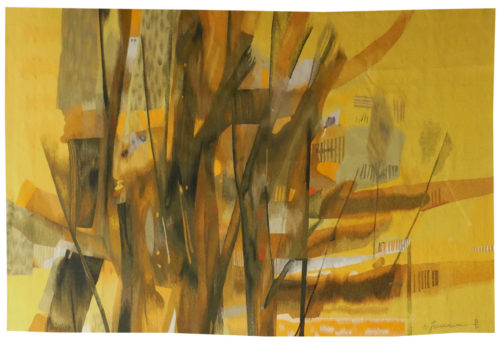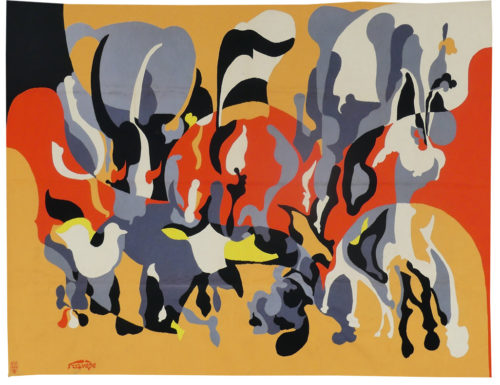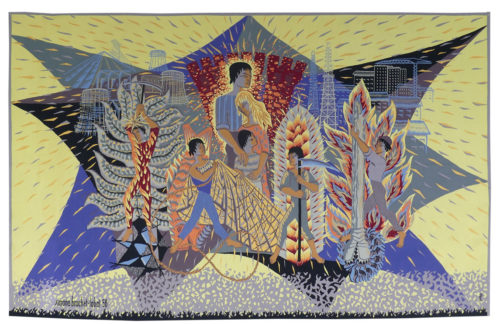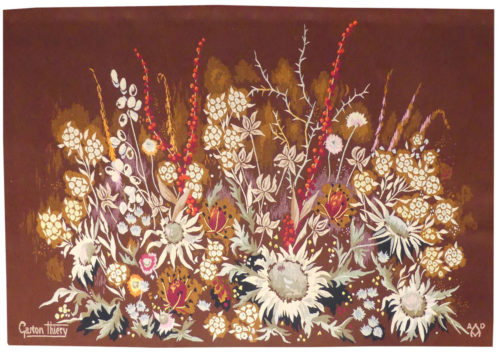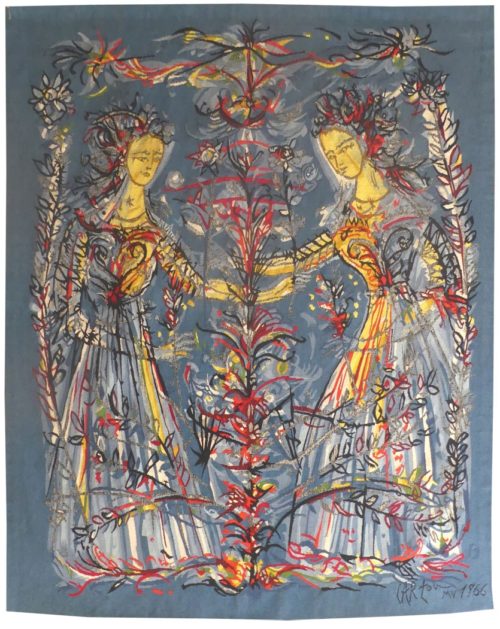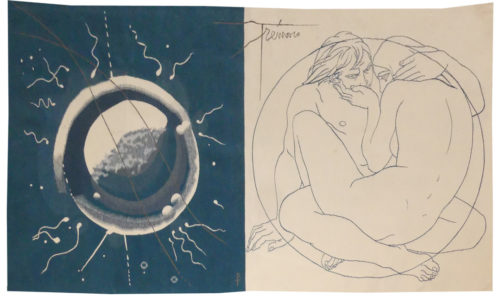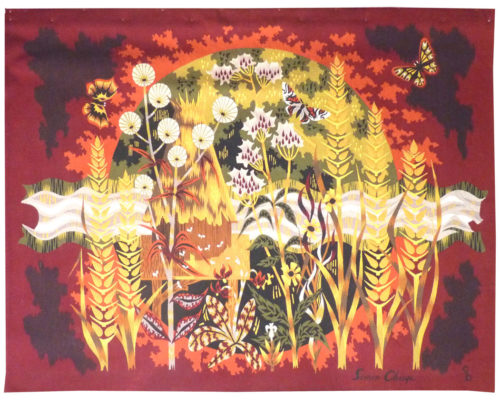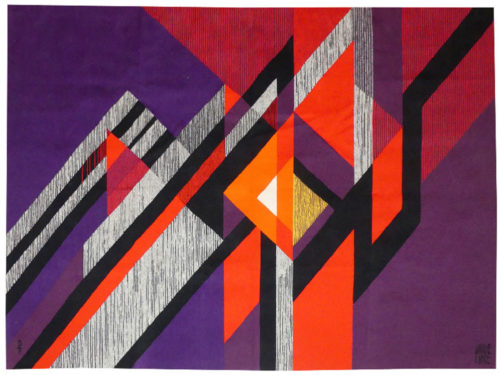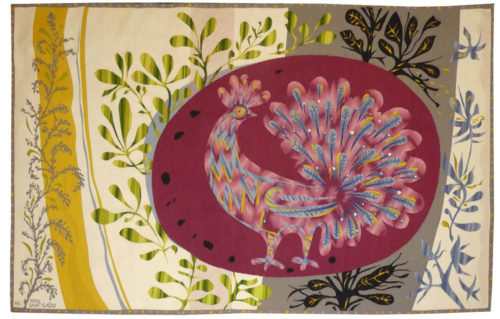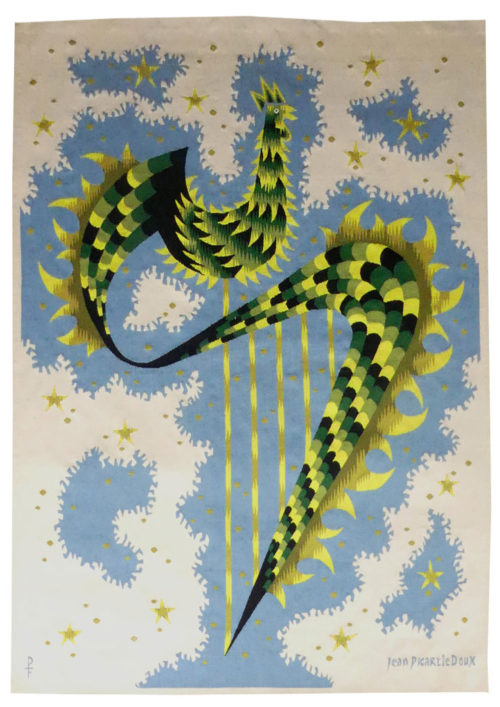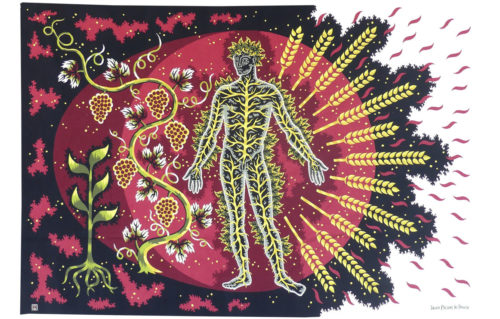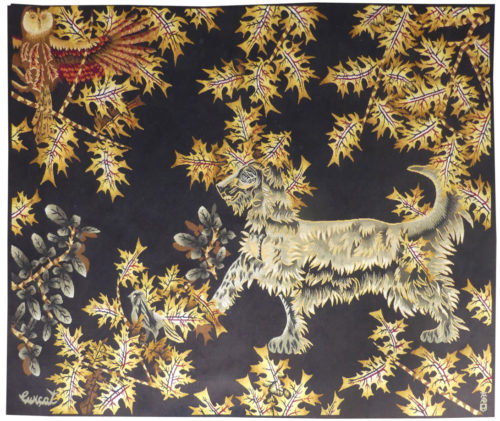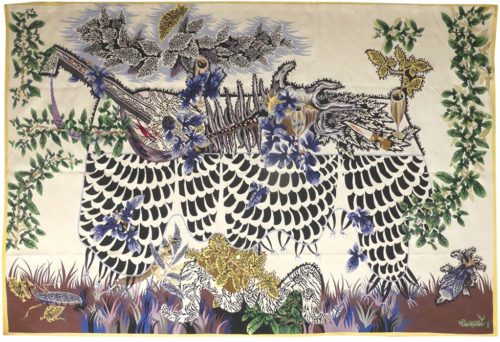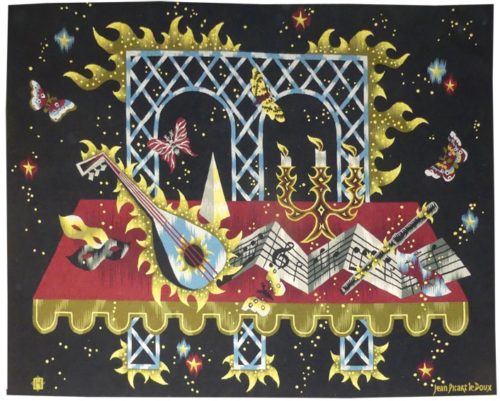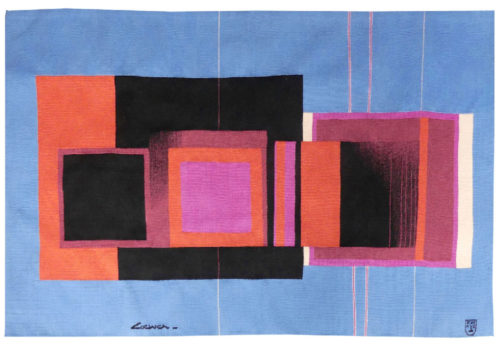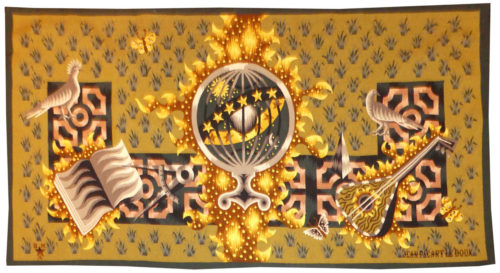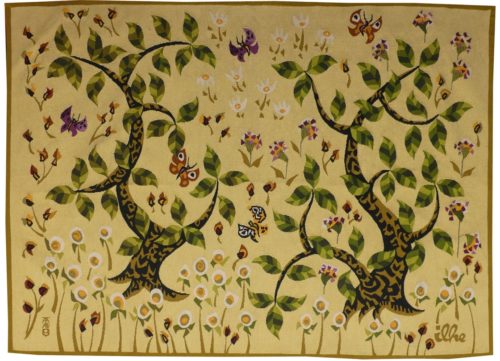-
Foujita is one of a number of artists whose work was woven at Bièvres at the Moulin de Vauboyen (hence the mark MV woven into the tapestries), which was transformed by Pierre de Tartas into an arts centre in 1959 and devoted to figurative art. Many noteworthy names would pass through including Cocteau, Foujita, Erni, Volti … among others, who would produce much work, often monumental, as well as realisations in the applied arts (notably book illustrations) Foujita realised only a few tapestry cartoons, all of which were produced at Bièvres by Pierre de Tartas. This one (an original watercolour 147 x 157 cm) was sold on 8th December 2015 by Tajan, and another preparatory drawing appeared in the Kimiyo Foujita succession (Cornette de St Cyr, 28th October 2013, n°167c). Likenesses of children become (even more) common in the period post 2nd world war : all with the same physical type a large forehead, widely spaced eyes, thin nose, full lips and regularly represented in slightly archaic roles redolent of Poulbot’s work.
-
Claude Bleynie discovered the art of tapestry with Jean Picart le Doux in 1952. He exhibited at the La Demeure gallery (from 1958) and participated in the main exhibitions devoted to mural art. His tapestry production counts more than 300 cartoons, mainly realised by the Andraud workshop. Bleynie, in a more abstract vein (which can also be found in his tapestries) notably designed cartoons for rugs which were intended for the luxurious appartment christened “Ile de France” on the ocean liner “France”. Bleynie, who also worked as a set designer in the theatre, designed numerous cartoons inspired by Dance and featuring animated masked and winged figures in fairy-like evocations.Aubusson tapestry woven in the Andraud workshop. Circa 1960.
-
Les petites algues (Small seaweed)
Aubusson tapestry woven by the Pinton workshop Complete with certificate of origin. Circa 1950. Jean Picart le Doux is one of the foremost figures in the renaissance of the art of tapestry. His earliest contributions to the field date back to 1943 when he designed cartoons for the passenger ship “la Marseillaise”. A close associate of Lurçat, whose theories he would adopt (limited palette, numbered cartoons…), he was a founding member of the A.P.C.T. (Association des Peintres-cartonniers de Tapisserie), and soon after, a teacher at the Ecole Nationale Supérieure des Arts Décoratifs. The state gave him several commissions most of them at the Aubusson workshop, and some at the Gobelins : the most spectacular of these being for the University of Caen, the Theatre in Le Mans, the passenger ship France or the Prefecture of the Creuse département … In as much as Picart le Doux’s aesthetic is close to that of Lurçat, so also is his insipiration and his subject matter, although in a register which is more decorative than symbolic, where he brings together heavenly bodies (the sun, the moon, the stars…), the elements, nature (wheat, vines, fish, birds…), man, literary quotation … Seaweed (and more generally the underwater world) was a theme in Picart le Doux’s work throughout his career, from “les algues” in 1946 onwards ; “Spiralgues”, “Buisson d’algues”, “les algues vertes”,... to name but a few. “Les petites algues” is a treatment, on a smaller scale, of the theme of “les algues” a cartoon 260 x 250 cm, edited by Leleu. The eponymous seaweed surround, lace-like, a central square where the real subject of the cartoon, a still-life arrangement of seashells and starfish, is framed. Bibliography : Marthe Belle-Joufray, Jean Picart le Doux, Publications filmées d’art et d’histoire, 1966 Maurice Bruzeau, Jean Picart le Doux, Murs de soleil, Editions Cercle d’art, 1972 Exhibition catalogue Jean Picart le Doux Tapisseries, Musée municipal d’Art et d’Histoire, Saint-Denis, 1976 Exhibition catalogue Jean Picart le Doux, Musée de la Poste, 1980 -
Foujita is one of a number of artists whose work was woven at Bièvres at the Moulin de Vauboyen (hence the mark MV woven into the tapestries), which was transformed by Pierre de Tartas into an arts centre in 1959 and devoted to figurative art. Many noteworthy names would pass through including Cocteau, Foujita, Erni, Volti ... among others, who would produce much work, often monumental, as well as realisations in the applied arts (notably book illustrations) Foujita realised only a few tapestry cartoons, all of which were produced at Bièvres by Pierre de Tartas. In this particular case, unlike the rest of his production, his style is different from that of his paintings : almost monochrome, stylised (quite different from the lithe brushwork of the artist); as for the biblical theme, it can be seen as the result of his recent conversion to catholicism. Another tapestry, of similar dimensions and subject matter, but in a differing, lighter colour scheme, was also woven at Bièvres.
Adam et Eve
Tapestry woven in the Moulin de Vauboyen workshop. 1967. -
Tropiques (Tropics)
On returning to France in the 1950’s after a lengthy period spent in Argentina, Berroeta produced quite a number of cartoons in a style which was first figurative (animals, human figures,...) then turned to abstraction, as in his paintings. The influence of cubism and a lyrical sense of colour cohabit here in a cartoon which could be seen as a reminiscence of South America.Aubusson tapestry woven in the Pinton workshop. Circa 1955. -
Les nymphéas (the waterlilies)
Aubusson tapestry woven in the Pinton workshop for the Verrière gallery. With label, n°4/6. 1968.With a taste for the large-scale, influenced by Untersteller at the Ecole des Beaux Arts, Hilaire undertook numerous mural paintings. In the same vein, beginning in 1949, along with a number of other artists stimulated by Lurçat, (he would join the latter at the A.P.C.T. Association des Peintres-Cartonniers de Tapisserie) he designed a number of cartoons some of which were woven at Beauvais or at Les Gobelins. Hilaire makes the subject, previously referenced by Monet, his own in his habitual, cubist (and tending towards the abstract) style, characterised by lines and circular shapes in an exalted blue and green colour scheme. His early passion for horticulture, which was originally to be his profession, here echoes that of Monet in Giverny. Bibliography : Exhibition catalogue Hilaire, œuvre tissé, galerie Verrière, 1970, ill. Exhibition catalogue, du trait à la lumière, Musée Départemental Georges de la Tour at Vic-sur-Seille, 2010. -
Faiseur d'étoiles (Starmaker)
After the traditional completion of some mural paintings in the 1930’s, he then arrived in Aubusson in 1936, became closely associated with Picart le Doux in 1947 and then joined the A.P.C.T. (Association des Peintres-Cartonniers de Tapisserie). From then on he devoted himself to tapestry with zeal and designed 167 cartoons, at first figurative following on from Picart le Doux and Saint-Saëns, then, influenced by the scientific themes that he dealt with, tending more towards abstraction. In 1981, two years before his death, he donated his studio to the Musée départemental de la tapisserie in Aubusson. Jullien’s interest in science and technology was evident early on in his career, at the end of the 1950’s, and this position singled him out somewhat among the other designers of the post-war period known in France as the “30 glorieuses” (despite a few works by Matégot, Maurice André and particularly Millecamps). Jullien imagined in 1961 an exhibition of his works entitled “Espace Poétique de l’Industrie” (Poetry in Industry) where he exhibited “Diamant noir” (the coal mine), Métropolis (oil refineries), ..., and this piece “Faiseur d’étoiles”, an allegory of autogenous welding. Bibliography : Exhibition Catalogue, Espace poétique de l'industrie, galerie La Demeure, 1961 (ill.) Exhibition catalogue Hommage à Louis-Marie Jullien, Aubusson, Musée départemental de la Tapisserie, 1983Aubusson tapestry woven in the André workshop. With signed label, n°3/3. 1957. -
Le réviseur (the reviser)
Aubusson tapestry woven by the Picaud workshop. With label, n°1/8. Circa 1980. Marc Petit met Jean Lurçat in 1954, went to Aubusson in 1955, exhibited his work for the first time at La Demeure in 1956, became a member of the A.P.C.T. (Association des Peintres-Cartonniers de Tapisserie) in 1958. After this lightning start to his career, he produced hundreds of cartoons, in a style all his own, where long-legged waders and acrobats wend in and out of dreamscapes. An amusing design, which could be interpreted as the illustration of the antithesis of an author and his editor : here depicted by the curious association of a bird and a fish, in an extremely lively colour scheme. -
Oiseaux de proie (Birds of prey)
Aubusson tapestry woven in the Goubely workshop. With label, signed with stamp, and by the artit's son, n°6/6. 1941.Gromaire’s woven pieces are few in number : 11 cartoons, designed between 1938 and 1944, most of them in Aubusson. “His rigorous construction, his use of simplification, his penchant for grand composition and grand fundamental ideas, his knowledgeable use of colour and in sum his supreme quality as a master-craftsman, all of those things were to make of him one of the most expert tapestry artists of his time”, so wrote Jean Cassou (Exhibition catalogue, Marcel Gromaire, Paris, Musée Nationale d’art moderne, 1963). It was Guillaume Janneau, then in the chair of the Mobilier National, who contacted him in 1938, convinced that his style (simplification of shape, geometrical designs framed in black, influenced by cubism, limited colour schemes…) would have something to contribute to the resolution of the new aesthetic problems that the art of tapestry would have to confront in order to bring about its renewal (simplified palette, synthetic cartoon design...) firstly with a commission for a work on the theme of the four elements, then with a second (“les saisons”, the seasons) which would be produced at Aubusson. In 1940 Gromaire joined Lurçat and Dubreuil there. Working alone, with great meticulosity (numerous drawings anticipate the cartoon which is painted rather than numbered as with Lurçat), in close collaboration with Suzanne Goubely, who would weave all his cartoons, he spent 4 years in Aubusson, during which time he devoted all his creative energy to tapestry. At the end of the war, he left the Creuse and produced no more cartoons, leaving to Lurçat the position of grand initiator of the tapestry renewal movement. « Oiseaux de proie » is one of the 5 tapestry cartoons designed by Gromaire for the Goubely workshop during the war and it is emblematic of his style : inspired by local landscapes, the absence of perspective, the strictly organised yet rich and highly abundant style, a limited palette (it is interesting to note the use at this period when France was occupied, the dominant colours of red, white and blue)... The atmosphere of this piece is more menacing than that of other pre-existing works.Bibliography : Tapisseries contemporaines Lurçat Gromaire, éditions Braun et cie, 1943, ill. Le Point, Aubusson et la renaissance de la Tapisserie, mars 1946, ill. p.35 Jean Lurçat, Tapisserie française, Bordas, 1947, plate 25 J. Cassou, M. Damain, R. Moutard-Uldry, la tapisserie française et les peintres cartonniers, Tel, 1957 Exhibition catalogue, Gromaire, œuvre tissée, Aubusson, Musée de la tapisserie, 1995, reproduced on p. 49 Symposium Jean Lurçat et la renaissance de la tapisserie in Aubusson, Aubusson, Musée départemental de la tapisserie 1992, ill. n°14 (detail) Exhibition catalogue La manufacture des Gobelins dans la première moitié du XXe siècle, Beauvais, Galerie nationale de la tapisserie, 1999. -
Mirage
Fumeron designed his first cartoons (he would ultimately make over 500) in the 1940’s, in collaboration with the Pinton workshop, he was then commissioned on numerous occasions by the state before participating in the decoration of the ocean liner “France”. His work was figurative to begin with and influenced by Lurçat, then turned towards abstraction, before coming back to a style characterised by colourful figurative and realistic depictions from the 1980’s onwards. This is a particularly interesting cartoon by Fumeron, one of his best in an abstract vein which puts him on an equal footing with Matégot.Aubusson tapestry woven in the Pinton workshop. With label. Circa 1965. -
Waistcoat l'enfant aux mirages (child with mirages)
Aubusson tapestry woven by the Legoueix workshop. 1997.Provenance : Sautour-Gaillard workshopA pupil of Wogensky at the Ecole Nationale Supérieure des Arts Appliqués, Sautour-Gaillard had his first cartoon woven in 1971 by the Legoueix workshop (a collaboration which was to last), and from then on he designed many very large-scale projects of which the most spectacular was “Pour un certain idéal” a series of 17 tapestries dealing with the theme of Olympianism (property of the Musée de l’Olympisme in Lausanne). If at first close to lyrical abstraction, the artist produced in the 1990’s cartoons superimposing different decorative motifs, textures and figures whose unity originated in the woven texture itself. The 2 waistcoats from the exhibition « Archéologies » which was held at the Inard gallery in 1997, are evidence of the wish expressed at the period by people from Aubusson, which was going through difficult times, to widen their activity : Sautour-Gaillard, who was himself an enthusiastic collector of fabrics, reveals here the same inspiration as in his contemporary woven collages. Bibliography : D. Cavelier, Jean-René Sautour-Gaillard, la déchirure, Lelivredart, 2013, ill. p.6, (worn by the artist) 296 -
La rivière d'argent (the silver river)
Aubusson tapestry woven in the Hamot workshop to the artist’s cartoon. With certificate of origin signed by the artist. 1965. It was in 1953 that Jean Picart le Doux proposed to Chaye to become his assistant and encouraged him to design tapestry cartoons : he would produce numerous bucolic cartoons, but also views of Normandy (Mont Saint Michel, Honfleur, regattas,…) whence he came. A classic cartoon in the naturalistic vein of this particular artist, who made a speciality of enclosures, hedges and riverbanks with animals. Bibliography : Simon Chaye tapisseries contemporaines, Editions Librairie des musées, 2014, ill. p.32 -
Chili
Lurçat’s artistic production was immense : it is however his role as the renovator of the art of tapestry design which ensures his lasting renown. As early as 1917, he started producing works on canvas, then in the 20’s and 30’s, he worked with Marie Cuttoli. His first collaboration with the Gobelins workshop dates back to 1937, at the same time he discovered the tapestry of the Apocalypse which was essential in his decision to devote himself to tapestry design. He first tackled the technical aspects with François Tabard, then on his installation at Aubusson during the war, he established his technique : broad point, a simplified palette, outlined cartoons with colours indicated by pre-ordained numbers. A huge production then follows (over 1000 cartoons) amplified by his desire to include his painter friends, the creation of the A.P.C.T. (Association des Peintres-Cartonniers de Tapisserie) and the collaboration with the art gallery La Demeure and Denise Majorel, and then by his role as a tireless advocate for the medium around the world. His tapestries reveal a pictorial world which is specifically decorative, with a very personal symbolic iconography : cosmogony (the sun, the planets, the zodiac, the four elements…) stylised vegetation, fauna (rams, cocks, butterflies, chimera …) standing out against a background without perspective (voluntarily different from painting) and, in his more ambitious work, designed as an invitation to share in a poetic (he sometimes weaves quotations into his tapestries) and philosophical (the grand themes are broached from the wartime period onwards) vision whose climax is the “Chant du Monde” (Song of the World) (Jean Lurçat Museum , ancien hôpital Saint Jean, Angers) which remained unfinished at his death. As is often the case, the title makes a reference to Latin America. As for the circular motif accompanying the owl, it is a classic as in, for example, “Forêt bleue” or “La chouette des figuiers”,... Bibliography : Tapisseries de Jean Lurçat 1939-1957, Pierre Vorms Editeur, 1957 Exhibition Catalogue Lurçat, 10 ans après, Musée d’Art moderne de la ville de Paris, 1976 Exhibition catalogue Les domaines de Jean Lurçat, Angers, Musée Jean Lurçat et de la tapisserie contemporaine, 1986 Symposium Jean Lurçat et la renaissance de la tapisserie in Aubusson, Aubusson, Musée départemental de la tapisserie 1992 Exhibition Catalogue Dialogues avec Lurçat, Musées de Basse-Normandie, 1992 Exhibition catalogue Jean Lurçat, Donation Simone Lurçat, Académie des Beaux-Arts, 2004 Jean Lurçat, le chant du monde Angers 2007 Gérard Denizeau, Jean Lurçat, Liénart, 2013 Exhibition Catalogue Jean Lurçat, Meister der französischen Moderne, Halle, Kunsthalle, 2016 Exhibition Catalogue Jean Lurçat au seul bruit du soleil, Paris, galerie des Gobelins, 2016Aubusson tapestry woven in the Pinton workshop. With signed label. Circa 1955. -
Le compotier (the fruit stand)
Jean Picart le Doux is one of the foremost figures in the renaissance of the art of tapestry. His earliest contributions to the field date back to 1943 when he designed cartoons for the passenger ship “la Marseillaise”. A close associate of Lurçat, whose theories he would adopt (limited palette, numbered cartoons...), he was a founding member of the A.P.C.T. (Association des Peintres-cartonniers de Tapisserie), and soon after, a teacher at the Ecole Nationale Supérieure des Arts Décoratifs. The state gave him several commissions most of them at the Aubusson workshop, and some at the Gobelins : the most spectacular of these being for the University of Caen, the Theatre in Le Mans, the passenger ship France or the Prefecture of the Creuse département ... In as much as Picart le Doux’s aesthetic is close to that of Lurçat, so also is his insipiration and his subject matter, although in a register which is more decorative than symbolic, where he brings together heavenly bodies (the sun, the moon, the stars...), the elements, nature (wheat, vines, fish, birds...), man, literary quotation ... A trellis background, reguarly found in Picart le Doux’s work in the 1950’s, notably in « Nature morte à la fontaine », woven at the Gobelins in 1952, is the expression of a certain decorative inclination to a style of tapestry popular in earlier times. “Le compotier” is a reworking of “les fruits et la guitare”, a larger work, woven at the Berthaut workshop in 1955. Bibliography : Maurice Bruzeau, Jean Picart le Doux, Murs de soleil, Editions Cercle d’art, 1972, ill. n°64 Exhibition catalogue Jean Picart le Doux Tapisseries, Musée municipal d’Art et d’Histoire, Saint-Denis, 1976 Exhibition catalogue Jean Picart le Doux, Musée de la Poste, 1980Aubusson tapestry woven by the Braquenié workshop. Complete with signed label. 1956. -
Le Méridien étoilé (the starry meridian)
Aubusson tapestry woven in the Berthaut workshop. circa 1948.Jean Picart le Doux is one of the foremost figures in the renaissance of the art of tapestry. His earliest contributions to the field date back to 1943 when he designed cartoons for the passenger ship “la Marseillaise”. A close associate of Lurçat, whose theories he would adopt (limited palette, numbered cartoons…), he was a founding member of the A.P.C.T. (Association des Peintres-cartonniers de Tapisserie), and soon after, a teacher at the Ecole Nationale Supérieure des Arts Décoratifs. The state gave him several commissions most of them at the Aubusson workshop, and some at the Gobelins : the most spectacular of these being for the University of Caen, the Theatre in Le Mans, the passenger ship France or the Prefecture of the Creuse département … In as much as Picart le Doux’s aesthetic is close to that of Lurçat, so also is his inspiration and his subject matter, although in a register which is more decorative than symbolic, where he brings together heavenly bodies (the sun, the moon, the stars…), the elements, nature (wheat, vines, fish, birds…), man, literary quotation … This cartoon is extracted from « Cosmogonie » (Bruzeau n°11), from 1948, here presented in a vertical format and without featuring the quotation from Goethe. The theme of the Astrolabe will be recurrent in his work, notably his eponymous tapestry of 1955. Bibliography : Marthe Belle-Jouffray, Jean Picart le Doux, Publications filmées d’art et d’histoire, 1966 Maurice Bruzeau, Jean Picart le Doux, Murs de soleil, Editions Cercle d’art, 1972 Exhibition Catalogue, Jean Picart le Doux, tapisseries, Musée de Saint-Denis, 1976 Exhibition Catalogue Jean Picart le Doux, Musée de la Poste, 1980 -
Solaire (solar )
Aubusson tapestry woven in Pinton workshop. With a label signed by the artist, n°2/6. Circa 1970.Odette Caly, who specialised in the depiction of bouquets, designed numerous cartoons for Aubusson, woven in the Pinton, Henry or Hamot workshops. Her inspiration, rather rural usually, has oriented here towards more exotic flowers, highlighted by the green background. Bibliography : Multi-authored, Caly, Filmed Publications of Art and History, 1972, reproduced No. 24 -
Rendez-vous des oiseaux (the bird's meeting point)
Aubusson tapestry woven in the Berthaut workshop. With label. 1951.Jean Picart le Doux is one of the foremost figures in the renaissance of the art of tapestry. His earliest contributions to the field date back to 1943 when he designed cartoons for the passenger ship “la Marseillaise”. A close associate of Lurçat, whose theories he would adopt (limited palette, numbered cartoons...), he was a founding member of the A.P.C.T. (Association des Peintres-cartonniers de Tapisserie), and soon after, a teacher at the Ecole Nationale Supérieure des Arts Décoratifs. The state gave him several commissions most of them at the Aubusson workshop, and some at the Gobelins : the most spectacular of these being for the University of Caen, the Theatre in Le Mans, the passenger ship France or the Prefecture of the Creuse département ... In as much as Picart le Doux’s aesthetic is close to that of Lurçat, so also is his insipiration and his subject matter, although in a register which is more decorative than symbolic, where he brings together heavenly bodies (the sun, the moon, the stars...), the elements, nature (wheat, vines, fish, birds...), man, literary quotation ... Birds are a recurring motif of the artist in the first half of the 50s, as well as the flames punctuated by dots on the rim, one of Picart le Doux's signatures. Moreover, the limited chromatic range is reminiscent of traditional "verdures" tapestries. This tapestry is reproduced in Bruzeau's book, as No. 30. Bibliography : Maurice Bruzeau, Jean Picart le Doux, Murs de soleil, Editions cercle d'art, 1972 -
Le petit oiseleur (the little bird-catcher)
Aubusson tapestry woven by the Picaud workshop. With label, n°1/6. Circa 1970.Elie Grekoff, whose aesthetic is similar to that of Lurçat, designed over 300 cartons.“The little bird catcher” is typical of a vein characteristic of Grekoff where melancholic children consider each other within a dream-like landscape against a background of large flat areas of colour, redolent of an illustration for a folk tale. -
Concert champêtre (Outdoor concert)
Needle-work tapestry. Circa 1965. « It is thus easy to understand that, having based my painting on my love of tapestry, it was relatively easy for me, and particularly tempting, to produce tapestries which were faithful to my painting” writes the artist in the exhibition catalogue for the 1970 show at the Galerie Verrière. It is not until 1961 that he started making designs (over 50) both for woven tapestries (at Aubusson, but also for the Mobilier National with, on occasion, the collaboration of Pierre Baudoin), but also those employing needlepoint. The artist’s very audacious palette is immediately recognisable in these cartons, with their use of primary colours or, as here, revolving around a very vivid pink with a rather dislocated storyline between the concert in the foreground and the hunting scene in the distance. Provenance : Elmina Auger collection Bibliography : Exhibition catalogue, Lapicque tapisseries, Paris, galerie Villand & Galanis, 1964-1965 Exhibition catalogue, Lapicque, Lyons, Galerie Verrière 1970 -
Cadran solaire (Sundial)
It was in 1953 that Jean Picart le Doux proposed to Chaye to become his assistant and encouraged him to design tapestry cartoons : he would produce numerous bucolic cartoons, but also views of Normandy (Mont Saint Michel, Honfleur, regattas,…) from whence he came. In order to express Nature’s harmony, Chaye includes in this characteristic scene of a river bank animated by flowers and animals, a sign of human presence, static and discreet : a sundial. Bibliography : Simon Chaye tapisseries contemporaines, Editions Librairie des musées, 2014, ill. p.29Aubusson tapestry woven in the Legoueix workshop. With signed label, n°6/6. 1969. -
L'étang (the pond)
Aubusson tapestry woven in theTabard workshop. With label. Circa 1950.Lurçat’s artistic production was immense : it is however his role as the renovator of the art of tapestry design which ensures his lasting renown. As early as 1917, he started producing works on canvas, then in the 20’s and 30’s, he worked with Marie Cuttoli. His first collaboration with the Gobelins workshop dates back to 1937, at the same time he discovered the tapestry of the Apocalypse which was essential in his decision to devote himself to tapestry design. He first tackled the technical aspects with François Tabard, then on his installation at Aubusson during the war, he established his technique : broad point, a simplified palette, outlined cartoons with colours indicated by pre-ordained numbers. A huge production then follows (over 1000 cartoons) amplified by his desire to include his painter friends, the creation of the A.P.C.T. (Association des Peintres-Cartonniers de Tapisserie) and the collaboration with the art gallery La Demeure and Denise Majorel, and then by his role as a tireless advocate for the medium around the world. His tapestries reveal a pictorial world which is specifically decorative, with a very personal symbolic iconography : cosmogony (the sun, the planets, the zodiac, the four elements…) stylised vegetation, fauna (rams, cocks, butterflies, chimera …) standing out against a background without perspective (voluntarily different from painting) and, in his more ambitious work, designed as an invitation to share in a poetic (he sometimes weaves quotations into his tapestries) and philosophical (the grand themes are broached from the wartime period onwards) vision whose climax is the “Chant du Monde” (Song of the World) (Jean Lurçat Museum , ancien hôpital Saint Jean, Angers) which remained unfinished at his death. Fish in their natural habitat surrounded by foliage in a characteristically profuse style. An owl, also a habitual character, looks on. Bibliography : Tapisseries de Jean Lurçat 1939-1957, Pierre Vorms Editeur, 1957 Exhibition Catalogue Lurçat, 10 ans après, Musée d'Art moderne de la ville de Paris, 1976 Exhibition catalogue Les domaines de Jean Lurçat, Angers, Musée Jean Lurçat et de la tapisserie contemporaine, 1986 Symposium Jean Lurçat et la renaissance de la tapisserie in Aubusson, Aubusson, Musée départemental de la tapisserie 1992 Exhibition Catalogue Dialogues avec Lurçat, Musées de Basse-Normandie, 1992 Exhibition catalogue Jean Lurçat, Donation Simone Lurçat, Académie des Beaux-Arts, 2004 Jean Lurçat, le chant du monde Angers 2007 Gérard Denizeau, Jean Lurçat, Liénart, 2013 Exhibition Catalogue Jean Lurçat au seul bruit du soleil, Paris, galerie des Gobelins, 2016 -
Petite harpe des bois (little harp of the woods)
Tapestry woven in the Picaud workshop. Complete with certificate of origin signed by the artist's widow, n°3/6. Circa 1975. Jean Picart le Doux is one of the foremost figures in the renaissance of the art of tapestry. His earliest contributions to the field date back to 1943 when he designed cartoons for the passenger ship “la Marseillaise”. A close associate of Lurçat, whose theories he would adopt (limited palette, numbered cartoons...), he was a founding member of the A.P.C.T. (Association des Peintres-cartonniers de Tapisserie), and soon after, a teacher at the Ecole Nationale Supérieure des Arts Décoratifs. The state gave him several commissions most of them at the Aubusson workshop, and some at the Gobelins : the most spectacular of these being for the University of Caen, the Theatre in Le Mans, the passenger ship France or the Prefecture of the Creuse département ... In as much as Picart le Doux’s aesthetic is close to that of Lurçat, so also is his insipiration and his subject matter, although in a register which is more decorative than symbolic, where he brings together heavenly bodies (the sun, the moon, the stars...), the elements, nature (wheat, vines, fish, birds...), man, literary quotation ... This cartoon refers back to « la harpe des forêts”, the sylvan harp, of 1953 (Bruzeau n°45). The link between music and nature is a leitmotiv in the work of Picart le Doux : these tapestries are often animated by birds outlined agains the vertical background of the strings. Bibliography : Maurice Bruzeau, Jean Picart le Doux, Murs de soleil, Editions Cercle d’art, 1972 Exhibition catalogue Jean Picart le Doux Tapisseries, Musée municipal d’Art et d’Histoire, Saint-Denis, 1976 Exhibition catalogue Jean Picart le Doux, Musée de la Poste, 1980 Exhibition Catalogue le salon de musique, église du château, Felletin, 2002, ill. p.54 -
La Lyre (The lyre)
Aubusson tapestry woven in the Pinton workshop. Circa 1960. Jean Picart le Doux is one of the foremost figures in the renaissance of the art of tapestry. His earliest contributions to the field date back to 1943 when he designed cartoons for the passenger ship “la Marseillaise”. A close associate of Lurçat, whose theories he would adopt (limited palette, numbered cartoons...), he was a founding member of the A.P.C.T. (Association des Peintres-cartonniers de Tapisserie), and soon after, a teacher at the Ecole Nationale Supérieure des Arts Décoratifs. The state gave him several commissions most of them at the Aubusson workshop, and some at the Gobelins : the most spectacular of these being for the University of Caen, the Theatre in Le Mans, the passenger ship France or the Prefecture of the Creuse département ... In as much as Picart le Doux’s aesthetic is close to that of Lurçat, so also is his insipiration and his subject matter, although in a register which is more decorative than symbolic, where he brings together heavenly bodies (the sun, the moon, the stars...), the elements, nature (wheat, vines, fish, birds...), man, literary quotation ... The image of the lyre, and also that of the harp, is one of the leitmotivs of the artist. Representative of Apollo, the lyre regularly appears with the sun (cf for example “Soleil-lyre”; Bruzeau n°82), but also as a symbol of the passing of time (similar to the use of the pendulum in the XVIIIth century, interestingly one of the artist’s cartoons is titled “the Pendulum”, auction in Lille 17.06.01 n°464) : “les Phases du temps” (the phases of time, cf Armelle Bouchet Mazas, le paquebot France, Editions Norma, 2006, p.72) which adorned the 1st class smoking room on the France. Strangely enough, our tapestry does not figure in Bruzeau’s book : possibly because it was specially commissioned for a scientific or industrial organisation, if one considers the form which appears with the lyre. Bibliography : Maurice Bruzeau, Jean Picart le Doux, Murs de soleil, Editions Cercle d'art, 1972 Armelle Bouchet Mazas, le paquebot France, Editions Norma, 2006 -
Holger was a student at the Ecole Nationale d’Art Décoratif d’Aubusson and worked with Lurçat before the latter’s death in 1966. He designed numerous dream-like cartoons woven by the Aubusson workshop. Now settled in the United States, he remains a tireless advocate for, and witness to, modern tapestry design, organising exhibitions and lectures on the subject.
Kosmische Vision (Cosmic vision)
Aubusson tapestry woven in the Pintron frères workshop. With certificate of origin. Circa 1970. -
Composition
Fumeron designed his first cartoons (he would ultimately make over 500) in the 1940’s, in collaboration with the Pinton workshop, he was then commissioned on numerous occasions by the state before participating in the decoration of the ocean liner “France”. His work was figurative to begin with and influenced by Lurçat, then turned towards abstraction, before coming back to a style characterised by colourful figurative and realistic depictions from the 1980’s onwards. An abstract cartoon, typical of the artist’s work, in a style which are redolent of Borderie or Wogensky, and which bear witness to the unceasing originality of his creativity.Aubusson tapestry woven in the Pinton workshop. N°1/6. Circa 1960. -
Composition
Aubusson tapestry woven in the Picaud workshop. Circa 1960.Born in 1912, Farvèze is one of the second generation of painter-cartonniers whose heyday dates from the end of the 1950’s, with the likes of Grékoff, Ferréol, Petit, Potin, … Influenced both by his meeting with Gleizes and a trip to Senegal which brought prestigious state commissions, he would be chosen to participate in the second Biennale de Lausanne in 1965. This piece is characterised by a highly stylised and very colourful design ; the absence of the certificate of origin means that we have no indication of the title or subject - although various animal-shaped forms can be distinguished. -
Le veilleur (the watchman)
A member of the A.P.C.T. (Association des Peintres-Cartonniers de Tapisserie), Wogensky is one of the many artists who would follow in Lurçat’s footsteps immediately after the war. At first influenced by his predecessor, Wogensky’s subsequent work (159 cartoons according to the 1989 exhibition catalogue) would evolve during the 1960’s towards a, not completely self-avowed, lyrical abstraction, from cosmic-astronomical themes expressed in decomposed, moving, birdlike shapes to cartoons both more refined and less dense. Although always claiming to be a painter, the artist’s conception of tapestry is extremely well thought out : “the realisation of a mural cartoon…. requires the consideration of a space which is no longer ours alone, by the nature of its dimensions, its scale, it also imposes a grand gesture which transforms and accentuates our presence.” Symptomatic of the heroic period at the end of the 1940’s, which also saw the blossoming of such talents as Tourlière, Lagrange, Matégot,..., all of whom were still young, inspired by Lurçat, and at the same time trying to assert their independent styles, whilst still remaining figurative, “le veilleur” affirms in a lyrical and brightly coloured style, its proximity to daily life (viz the detail of the striped jacket), and, at the same time, a highly symbolic connotation : a figure on the look-out in uncertain times. Bibliography : J. Cassou, M. Damain, R. Moutard-Uldry, la tapisserie française et les peintres cartonniers, Tel, 1957, ill. p.131 Exhibition catalogue Robert Wogensky, Aubusson, Musée départemental de la tapisserie, 1989, ill. p.15 Exhibition catalogue Robert Wogensky, Angers, Musée Jean Lurçat et de la Tapisserie Contemporaine, 1989 Exhibition Catalogue Jean Lurçat, compagnons de route et passants considérables, Felletin, Eglise, 1992, ill. p.46Aubusson tapestry woven by the Legoueix workshop. With label. 1948. -
Allégorie des métiers (Allegory of trades)
Aubusson tapestry woven by the Braquenié workshop. 1958.A curious cartoon where, against a vaguely hexagonal (reference to France, often referred to as “l’hexagone”) star-shaped background are pictured the family, traditional trades (fisherman, farmer,...) placed in front of gasometres, cranes and other emblems of modernity : a hymn to reconstruction, a political allegory, a work of propaganda,... ? -
Vercors
Aubusson tapestry woven by the Pinton workshop. With signed label, n°2/6. Circa 1965.Maurice André settled in Aubusson for the duration of the second world war. A founding member of the group “Tapisserie de France” and a member of the A.P.C.T. (Association des Peintres-Cartonniers de Tapisserie), he developed a personal style, different from that of Lurçat, characterised by rigorous, cubist-influenced flat areas of colour, often using a limited palette ; he received large-scale public commissions for the Council of Europe in Strasbourg (“L’Europe unie dans le Travail et la Paix”) or for the French pavilion at the Brussels Exhibition in 1958 (“La Technique moderne au service de l’Homme”). Gradually (as with Wogensky and Prassinos,...) his style evolved towards more abstraction, firstly lyrical and then more and more geometric, in a way very similar to Matégot. In the mid 1960’s André’s style becomes comparable to that of Matégot, where battage, pick and pick and shading are the norm. Varying shades of green and triangular shapes are the means of evoking the peaks of the Vercors. -
Flore des Baronnies (Baronnies's Flora)
Aubusson tapestry woven in the Andraud workshop. With label, n°1/6. 1974.A student of Léon Detroy, Gaston Thiéry is one of the last representatives of the Crozant school of painting. Established in the Creuse region of France, he started working on tapestries in 1965 with the Andraud workshop for whom he designed cartoons inspired by the local flora, in a decorative style which can be situated somewhere between that of Dom Robert and Maingonnat, a world away from his landscape paintings which were strongly influenced by the impressionists. -
Les Jumelles (the twins)
Tapestry woven in the Moulin de Vauboyen workshop. With signed label, n°3/8. 1966.Carzou is one of a number of artists whose work was woven at Bièvres at the Moulin de Vauboyen (hence the mark MV woven into the tapestries), which was transformed by Pierre de Tartas into an arts centre in 1959 and devoted to figurative art. Many noteworthy names would pass through including Cocteau, Foujita, Erni, Volti ... among others, who would produce much work, often monumental, as well as realisations in the applied arts (notably book illustrations) Carzou was most noted at the start of his career as a decorative painter (notably for the theatre), and his work for tapestry is relatively rare. His style is immediately recognisable in this cartoon, the busy hatching illustrating dream-like subjects, not unlike work produced by Lucien Coutaud. -
Couple génétique (Genetic couple)
Aubusson tapestry woven by the Pinton workshop. With label. 1976.In this work – which is apparently the only cartoon by this artist – the deft line and clear drawing technique of Trémois are immediately recognisable. He is best known for his work as an engraver and illustrator, albeit having won the Grand Prix de Rome for his painting. Also evident, his predilection for the nude : here a loving embrace and a meditation on modern science are found in association in a surprising, and very personal, juxtaposition. -
Eaux vives (Wild water)
Aubusson tapestry woven in the Legoueix workshop. Complete with signed label, n°1/6. Circa 1970.Originally a sculptor exploiting very diverse materials (steel, concrete, clay…), Borderie came to tapestry with immense enthusiasm in the 1950’s with the weaving of his first cartoon in 1957. Receiving encouragement from Denise Majorel, he was awarded the Grand Prix National de la Tapisserie in 1962. In 1974 he was appointed as director at the Ecole Nationale des Arts Décoratifs at Aubusson but he resigned from this post shortly thereafter. He designed over 500 painted cartoons, abstracts using simple shapes, shading in a limited palette of colours and weaving with gros points. Despite its warm colours and lyrical shapes (notably the sinuous vertical swirl, ressembling water currents), “Eaux vives” remains a one-off in Borderie’s work : the habitual muted colour scheme is broken here by the striking central red oval. Bibliography : Exhibition catalogue André Borderie « pour l’homme simplement », Angers, Musée Jean Lurçat et de la Tapisserie Contemporaine 1998 J.J. et B. Wattel, André Borderie et la tapisserie d'Aubusson, Editions Louvre Victoire, 2018 -
L’enclos (Enclosure)
Aubusson tapestry woven in the Brivet workshop. With signed label, n°4/4. 1966.Bibliography : Simon Chaye tapisseries contemporaines, Editions Librairie des musées, 2014, ill. p.27It was in 1953 that Jean Picart le Doux proposed to Chaye to become his assistant and encouraged him to design tapestry cartoons : he would produce numerous bucolic cartoons, but also views of Normandy (Mont Saint Michel, Honfleur, regattas,...) from whence he came. Here is a thoroughly characteristic cartoon of this artist who specialises in pastures, hedges and woodland scenes. -
Cuivres (Copper-coloured)
Lurçat’s artistic production was immense : it is however his role as the renovator of the art of tapestry design which ensures his lasting renown. As early as 1917, he started producing works on canvas, then in the 20’s and 30’s, he worked with Marie Cuttoli. His first collaboration with the Gobelins workshop dates back to 1937, at the same time he discovered the tapestry of the Apocalypse which was essential in his decision to devote himself to tapestry design. He first tackled the technical aspects with François Tabard, then on his installation at Aubusson during the war, he established his technique : broad point, a simplified palette, outlined cartoons with colours indicated by pre-ordained numbers. A huge production then follows (over 1000 cartoons) amplified by his desire to include his painter friends, the creation of the A.P.C.T. (Association des Peintres-Cartonniers de Tapisserie) and the collaboration with the art gallery La Demeure and Denise Majorel, and then by his role as a tireless advocate for the medium around the world. His tapestries reveal a pictorial world which is specifically decorative, with a very personal symbolic iconography : cosmogony (the sun, the planets, the zodiac, the four elements…) stylised vegetation, fauna (rams, cocks, butterflies, chimera …) standing out against a background without perspective (voluntarily different from painting) and, in his more ambitious work, designed as an invitation to share in a poetic (he sometimes weaves quotations into his tapestries) and philosophical (the grand themes are broached from the wartime period onwards) vision whose climax is the “Chant du Monde” (Song of the World) (Jean Lurçat Museum , ancien hôpital Saint Jean, Angers) which remained unfinished at his death. Copper-coloured is used to describe certain butterflies whose wings recall this brightly coloured metal. This cartoon is a re-take on “Sphinx and Cockerel” (but without the cockerel) in a highly decorative positive/negative contrast of yellow against a black background. Bibliography : Tapisseries de Jean Lurçat 1939-1957, Pierre Vorms Editeur, 1957 Exhibition Catalogue Lurçat, 10 ans après, Musée d'Art moderne de la ville de Paris, 1976 Exhibition catalogue Les domaines de Jean Lurçat, Angers, Musée Jean Lurçat et de la tapisserie contemporaine, 1986 Symposium Jean Lurçat et la renaissance de la tapisserie in Aubusson, Aubusson, Musée départemental de la tapisserie 1992 Exhibition Catalogue Dialogues avec Lurçat, Musées de Basse-Normandie, 1992 Exhibition catalogue Jean Lurçat, Donation Simone Lurçat, Académie des Beaux-Arts, 2004 Jean Lurçat, le chant du monde Angers 2007 Gérard Denizeau, Jean Lurçat, Liénart, 2013 Exhibition Catalogue Jean Lurçat au seul bruit du soleil, Paris, galerie des Gobelins, 2016Aubusson tapestry woven by the Pinton workshop. With signed label. Circa 1950. -
Composition
Aubusson tapestry woven in the Pinton workshop. N°1/6. Circa 1970.Maurice André settled in Aubusson for the duration of the second world war. A founding member of the group “Tapisserie de France” and a member of the A.P.C.T. (Association des Peintres-Cartonniers de Tapisserie), he developed a personal style, different from that of Lurçat, characterised by rigorous, cubist-influenced flat areas of colour, often using a limited palette ; he received large-scale public commissions for the Council of Europe in Strasbourg (“L’Europe unie dans le Travail et la Paix”) or for the French pavilion at the Brussels Exhibition in 1958 (“La Technique moderne au service de l’Homme”). Gradually (as with Wogensky and Prassinos,...) his style evolved towards more abstraction, firstly lyrical and then more and more geometric, in a way very similar to Matégot. Characteristic of André’s final period, the geometric shapes and flat areas of colour are tempered by hatching, stripes and shading. -
Faisan feu (Pheasant Fire)
Lurçat’s artistic production was immense : it is however his role as the renovator of the art of tapestry design which ensures his lasting renown. As early as 1917, he started producing works on canvas, then in the 20’s and 30’s, he worked with Marie Cuttoli. His first collaboration with the Gobelins workshop dates back to 1937, at the same time he discovered the tapestry of the Apocalypse which was essential in his decision to devote himself to tapestry design. He first tackled the technical aspects with François Tabard, then on his installation at Aubusson during the war, he established his technique : broad point, a simplified palette, outlined cartoons with colours indicated by pre-ordained numbers. A huge production then follows (over 1000 cartoons) amplified by his desire to include his painter friends, the creation of the A.P.C.T. (Association des Peintres-Cartonniers de Tapisserie) and the collaboration with the art gallery La Demeure and Denise Majorel, and then by his role as a tireless advocate for the medium around the world. His tapestries reveal a pictorial world which is specifically decorative, with a very personal symbolic iconography : cosmogony (the sun, the planets, the zodiac, the four elements…) stylised vegetation, fauna (rams, cocks, butterflies, chimera …) standing out against a background without perspective (voluntarily different from painting) and, in his more ambitious work, designed as an invitation to share in a poetic (he sometimes weaves quotations into his tapestries) and philosophical (the grand themes are broached from the wartime period onwards) vision whose climax is the “Chant du Monde” (Song of the World) (Jean Lurçat Museum , ancien hôpital Saint Jean, Angers) which remained unfinished at his death. This profile of the head of a cockerel appears in various cartoons (« Feux bleus », « la chanson de Roland »,…) : it appears, with its almond-shaped halo, as if in reserve, shining brightly against the black background. The title of this piece allows a play on words with the French “faire feu” an expression meaning to shoot. Bibliography : Tapisseries de Jean Lurçat 1939-1957, Pierre Vorms Editeur, 1957 Exhibition Catalogue Lurçat, 10 ans après, Musée d'Art moderne de la ville de Paris, 1976 Exhibition catalogue Les domaines de Jean Lurçat, Angers, Musée Jean Lurçat et de la tapisserie contemporaine, 1986 Symposium Jean Lurçat et la renaissance de la tapisserie in Aubusson, Aubusson, Musée départemental de la tapisserie 1992 Exhibition Catalogue Dialogues avec Lurçat, Musées de Basse-Normandie, 1992 Exhibition catalogue Jean Lurçat, Donation Simone Lurçat, Académie des Beaux-Arts, 2004 Jean Lurçat, le chant du monde Angers 2007 Gérard Denizeau, Jean Lurçat, Liénart, 2013 Exhibition Catalogue Jean Lurçat au seul bruit du soleil, Paris, galerie des Gobelins, 2016Aubusson tapestry woven in the Tabard workshop. With signed label. Circa 1960. -
Le paon (the peacock)
Tapestry woven by the Baudonnet workshop. With label. 1959.Lurçat approached Saint-Saëns, originally a painter of murals, in 1940. And during the war the latter produced the first of his allegorical masterpieces, tapestries reflecting indignation, combat, resistance : “les Vierges folles (the foolish virgins), “Thésée et le Minotaure” (Theseus and the Minotaur). At the end of the war, as a natural development he joined up with Lurçat, whose convictions he shared (concerning a simplified palette, outlined cartoons with colours indicated by pre-ordained numbers, and the specific nature of tapestry design…) at the A.P.C.T. (Association des Peintres-cartonniers de Tapisserie). His universe, where the human figure, stretched, elongated, ooccupies an important place (particularly when compared to his companions Lurçat or Picart le Doux), pivots around traditional themes : woman, the Commedia dell’arte, Greek mythology… refined by the brilliance of the colours and the simplification of the layout. His work would evolve later, in the 1960’s, towards cartoons of a more lyrical design, almost abstract where elemental and cosmic forces would dominate. The number and variety of animals used in his tapestries by Saint-Saëns is not so rich as others of his contemporaries such as Lurçat, Perrot or Dom Robert, principally known for his peacocks. Here the use, as if off the ground, of a similar motif (despite the fact that it more ressembles a cockerel than a peacock) illustrates the variety of solutions employed by the painter-cartonniers of the period. Bibliography : Exhibition catalogue Saint-Saëns, galerie La Demeure, 1970 Exhibition catalogue Saint-Saëns, the tapestries, Aubusson, Musée départemental de la Tapisserie, 1987 Exhibition catalogue Marc Saint-Saëns, tapestries, 1935-1979, Angers, Musée Jean Lurçat et de la Tapisserie Contemporaine 1997-1998 -
Le chant du matin (morning song)
Aubusson tapestry woven in the Pinton workshop. N°5/6. 1965. Jean Picart le Doux is one of the foremost figures in the renaissance of the art of tapestry. His earliest contributions to the field date back to 1943 when he designed cartoons for the passenger ship “la Marseillaise”. A close associate of Lurçat, whose theories he would adopt (limited palette, numbered cartoons...), he was a founding member of the A.P.C.T. (Association des Peintres-cartonniers de Tapisserie), and soon after, a teacher at the Ecole Nationale Supérieure des Arts Décoratifs. The state gave him several commissions most of them at the Aubusson workshop, and some at the Gobelins : the most spectacular of these being for the University of Caen, the Theatre in Le Mans, the passenger ship France or the Prefecture of the Creuse département ... In as much as Picart le Doux’s aesthetic is close to that of Lurçat, so also is his inspiration and his subject matter, although in a register which is more decorative than symbolic, where he brings together heavenly bodies (the sun, the moon, the stars...), the elements, nature (wheat, vines, fish, birds...), man, literary quotation ... An amusing allegory of a cock-harp, luminescent and joyous : if the title and the motif itself are reminiscent of the work of Jean Lurçat, the particularly decorative character of this piece is typical of Picart le Doux. Bibliography : Maurice Bruzeau, Jean Picart le Doux, Murs de soleil, Editions Cercle d’art, 1972, ill. n°147 Exhibition Catalogue, Jean Picart le Doux, tapisseries, Musée de Saint-Denis, 1976 Exhibition Catalogue Jean Picart le Doux, Musée de la Poste, 1980 -
L'Homme et la Terre (Man and the Earth)
Aubusson tapestry woven in the Hamot workshop. 1962. Jean Picart le Doux is one of the foremost figures in the renaissance of the art of tapestry. His earliest contributions to the field date back to 1943 when he designed cartoons for the passenger ship “la Marseillaise”. A close associate of Lurçat, whose theories he would adopt (limited palette, numbered cartoons...), he was a founding member of the A.P.C.T. (Association des Peintres-cartonniers de Tapisserie), and soon after, a teacher at the Ecole Nationale Supérieure des Arts Décoratifs. The state gave him several commissions most of them at the Aubusson workshop, and some at the Gobelins : the most spectacular of these being for the University of Caen, the Theatre in Le Mans, the passenger ship France or the Prefecture of the Creuse département ... In as much as Picart le Doux’s aesthetic is close to that of Lurçat, so also is his inspiration and his subject matter, although in a register which is more decorative than symbolic, where he brings together heavenly bodies (the sun, the moon, the stars...), the elements, nature (wheat, vines, fish, birds...), man, literary quotation ... At the turn of the 1960’s Picart le Doux conceived a series of large-scale cartoons (« Le Temps » Galaxie », « L’Homme et la Mer », …) all of which were spectacular allegories centred around Man at the centre of Creation. Here in “L’Homme et la Terre”, the vocabulary he uses : vines, ears of wheat, the human body irrigated by veins,...are all elements used in previous cartoons by the same artist. Bibliography : Maurice Bruzeau, Jean Picart le Doux, Murs de soleil, Editions Cercle d’art, 1972, ill. n°132 Exhibition Catalogue, Jean Picart le Doux, tapisseries, Musée de Saint-Denis, 1976 Exhibition Catalogue Jean Picart le Doux, Musée de la Poste, 1980 -
Composition
Aubusson tapestry woven in the Pinton workshop. With label, n°1/1. 1974. Jean Bazaine, like many of his contemporaries, was a prolific mural artist particularly for large scale edifices. Although he is above all recognised as a designer of stained glass windows and mosaics, he was also making tapestry cartoons as early as the 1930’s. These pieces formed part of the renewal of religious art of which Bazaine would be one of the principal protagonists, particularly after the war. However, Bazaine’s designs are not all destined to be displayed in a religious context. His mastery of mural art is revealed by commissions for mosaics for the UNESCO building and also for the Maison de la Radio as well as tapestries for the Manufactures Nationales or for Aubusson, for the Palais de Justice in Lille or the Hotel de Ville in Strasbourg. This is the context for a commission for this widely recognised, indeed almost official, artist (Grand Prix National des Arts in 1964, an exhibition at the Musée National d’Art Moderne in 1965) from the Federation Française du Bâtiment for its head office, at the beginning of the 1970’s. His response would be this vast, lyrical and rythmic composition in a homogeneous colour scheme. Unfortunately, the illegibility of the certificate of origin leaves us without a title for this work whose creator did not see himself as an abstract artist. Origin : The Head Office of the Federation Francaise du Bâtiment. -
Sphinx gris (grey hawk moth)
Aubusson tapestry woven in the Braquenié workshop. With signed label. Circa 1955. Lurçat’s artistic production was immense : it is however his role as the renovator of the art of tapestry design which ensures his lasting renown. As early as 1917, he started producing works on canvas, then in the 20’s and 30’s, he worked with Marie Cuttoli. His first collaboration with the Gobelins workshop dates back to 1937, at the same time he discovered the tapestry of the Apocalypse which was essential in his decision to devote himself to tapestry design. He first tackled the technical aspects with François Tabard, then on his installation at Aubusson during the war, he established his technique : broad point, a simplified palette, outlined cartoons with colours indicated by pre-ordained numbers. A huge production then follows (over 1000 cartoons) amplified by his desire to include his painter friends, the creation of the A.P.C.T. (Association des Peintres-Cartonniers de Tapisserie) and the collaboration with the art gallery La Demeure and Denise Majorel, and then by his role as a tireless advocate for the medium around the world. His tapestries reveal a pictorial world which is specifically decorative, with a very personal symbolic iconography : cosmogony (the sun, the planets, the zodiac, the four elements…) stylised vegetation, fauna (rams, cocks, butterflies, chimera …) standing out against a background without perspective (voluntarily different from painting) and, in his more ambitious work, designed as an invitation to share in a poetic (he sometimes weaves quotations into his tapestries) and philosophical (the grand themes are broached from the wartime period onwards) vision whose climax is the “Chant du Monde” (Song of the World) (Jean Lurçat Museum , ancien hôpital Saint Jean, Angers) which remained unfinished at his death. The grey hawk moth (or occasionally yellow, in another cartoon), moths and butterflies are a leitmotiv in Lurçat’s work. Here the colours are less contrasted than is his wont, in a highly nuanced composition. Bibliography : Tapisseries de Jean Lurçat 1939-1957, Pierre Vorms Editeur, 1957 Exhibition Catalogue Lurçat, 10 ans après, Musée d'Art moderne de la ville de Paris, 1976 Exhibition catalogue Les domaines de Jean Lurçat, Angers, Musée Jean Lurçat et de la tapisserie contemporaine, 1986 Symposium Jean Lurçat et la renaissance de la tapisserie in Aubusson, Aubusson, Musée départemental de la tapisserie 1992 Exhibition Catalogue Dialogues avec Lurçat, Musées de Basse-Normandie, 1992 Exhibition catalogue Jean Lurçat, Donation Simone Lurçat, Académie des Beaux-Arts, 2004 Jean Lurçat, le chant du monde Angers 2007 Gérard Denizeau, Jean Lurçat, Liénart, 2013 Exhibition Catalogue Jean Lurçat au seul bruit du soleil, Paris, galerie des Gobelins, 2016 -
Le basset (Basset hound)
Aubusson tapestry woven in the Tabard worshop. Complete with label. Circa 1950. Lurçat’s artistic production was immense : it is however his role as the renovator of the art of tapestry design which ensures his lasting renown. As early as 1917, he started producing works on canvas, then in the 20’s and 30’s, he worked with Marie Cuttoli. His first collaboration with the Gobelins workshop dates back to 1937, at the same time he discovered the tapestry of the Apocalypse which was essential in his decision to devote himself to tapestry design. He first tackled the technical aspects with François Tabard, then on his installation at Aubusson during the war, he established his technique : broad point, a simplified palette, outlined cartoons with colours indicated by pre-ordained numbers. A huge production then follows (over 1000 cartoons) amplified by his desire to include his painter friends, the creation of the A.P.C.T. (Association des Peintres-Cartonniers de Tapisserie) and the collaboration with the art gallery La Demeure and Denise Majorel, and then by his role as a tireless advocate for the medium around the world. His tapestries reveal a pictorial world which is specifically decorative, with a very personal symbolic iconography : cosmogony (the sun, the planets, the zodiac, the four elements…) stylised vegetation, fauna (rams, cocks, butterflies, chimera …) standing out against a background without perspective (voluntarily different from painting) and, in his more ambitious work, designed as an invitation to share in a poetic (he sometimes weaves quotations into his tapestries) and philosophical (the grand themes are broached from the wartime period onwards) vision whose climax is the “Chant du Monde” (Song of the World) (Jean Lurçat Museum , ancien hôpital Saint Jean, Angers) which remained unfinished at his death. Something of a dog lover, Lurçat owned Afghan hounds. They can be found occasionally in his cartoons and seemingly Lurçat found it difficult not to be influenced by their aspect : his basset hound (similar in style to another cartoon entitled “le chien vert” the green dog, but without the owl) scarcely merits its name. Bibliography : Tapisseries de Jean Lurçat 1939-1957, Pierre Vorms Editeur, 1957 Exhibition Catalogue Lurçat, 10 ans après, Musée d'Art moderne de la ville de Paris, 1976 Exhibition catalogue Les domaines de Jean Lurçat, Angers, Musée Jean Lurçat et de la tapisserie contemporaine, 1986 Symposium Jean Lurçat et la renaissance de la tapisserie in Aubusson, Aubusson, Musée départemental de la tapisserie 1992 Exhibition Catalogue Dialogues avec Lurçat, Musées de Basse-Normandie, 1992 Exhibition catalogue Jean Lurçat, Donation Simone Lurçat, Académie des Beaux-Arts, 2004 Jean Lurçat, le chant du monde Angers 2007 Gérard Denizeau, Jean Lurçat, Liénart, 2013 Exhibition Catalogue Jean Lurçat au seul bruit du soleil, Paris, galerie des Gobelins, 2016 -
Nappe blanche (White tablecloth)
Lurçat’s artistic production was immense : it is however his role as the renovator of the art of tapestry design which ensures his lasting renown. As early as 1917, he started producing works on canvas, then in the 20’s and 30’s, he worked with Marie Cuttoli. His first collaboration with the Gobelins workshop dates back to 1937, at the same time he discovered the tapestry of the Apocalypse which was essential in his decision to devote himself to tapestry design. He first tackled the technical aspects with François Tabard, then on his installation at Aubusson during the war, he established his technique : broad point, a simplified palette, outlined cartoons with colours indicated by pre-ordained numbers. A huge production then follows (over 1000 cartoons) amplified by his desire to include his painter friends, the creation of the A.P.C.T. (Association des Peintres-Cartonniers de Tapiisserie) and the collaboration with the art gallery La Demeure and Denise Majorel, and then by his role as a tireless advocate for the medium around the world. His tapestries reveal a pictorial world which is specifically decorative, with a very personal symbolic iconography : cosmogony (the sun, the planets, the zodiac, the four elements…) stylised vegetation, fauna (rams, cocks, butterflies, chimera …) standing out against a background without perspective (voluntarily different from painting) and, in his more ambitious work, designed as an invitation to share in a poetic (he sometimes weaves quotations into his tapestries) and philosophical (the grand themes are broached from the wartime period onwards) vision whose climax is the “Chant du Monde” (Song of the World) (Jean Lurçat Museum , ancien hôpital Saint Jean, Angers) which remained unfinished at his death. The theme of the laid table is a leitmotiv in Lurçat’s work as early as the 1940’s (cf The four corners, 1943 Goubely-Gatien workshop, Angers Musée Jean Lurçat et de la tapisserie contemporaine). These tables, often with connotations of the horn of plenty and often featuring musical instruments (most often the mandolin) recall the traditional still life’s of the XVIIth century, not, as it happens, a theme of contemporary tapestry. Bibliography : Tapisseries de Jean Lurçat 1939-1957, Pierre Vorms Editeur, 1957 Exhibition Catalogue Lurçat, 10 ans après, Musée d'Art moderne de la ville de Paris, 1976 Exhibition catalogue Les domaines de Jean Lurçat, Angers, Musée Jean Lurçat et de la tapisserie contemporaine, 1986 Symposium Jean Lurçat et la renaissance de la tapisserie in Aubusson, Aubusson, Musée départemental de la tapisserie 1992 Exhibition Catalogue Dialogues avec Lurçat, Musées de Basse-Normandie, 1992 Exhibition catalogue Jean Lurçat, Donation Simone Lurçat, Académie des Beaux-Arts, 2004 Jean Lurçat, le chant du monde Angers 2007 Gérard Denizeau, Jean Lurçat, Liénart, 2013 Exhibition Catalogue Jean Lurçat au seul bruit du soleil, Paris, galerie des Gobelins, 2016Aubusson tapestry woven in the Goubely workshop. Circa 1955. -
Hommage à Mozart (Homage to Mozart)
Jean Picart le Doux is one of the foremost figures in the renaissance of the art of tapestry. His earliest contributions to the field date back to 1943 when he designed cartoons for the passenger ship “la Marseillaise”. A close associate of Lurçat, whose theories he would adopt (limited palette, numbered cartoons...), he was a founding member of the A.P.C.T. (Association des Peintres-cartonniers de Tapisserie), and soon after, a teacher at the Ecole Nationale Supérieure des Arts Décoratifs. The state gave him several commissions most of them at the Aubusson workshop, and some at the Gobelins : the most spectacular of these being for the University of Caen, the Theatre in Le Mans, the passenger ship France or the Prefecture of the Creuse département ... In as much as Picart le Doux’s aesthetic is close to that of Lurçat, so also is his insipiration and his subject matter, although in a register which is more decorative than symbolic, where he brings together heavenly bodies (the sun, the moon, the stars...), the elements, nature (wheat, vines, fish, birds...), man, literary quotation ... Cartoons devoted to musical themes are extremely frequent in Picart le Doux’s work : forms (here the concerto), specific works (“La petite musique de nuit”, a little night music, another title for our work ; “Les 4 saisons”, the 4 seasons, for example) composers (“Hommage à Vivaldi”, “Hommage à Bach”, which was reproduced as a stamp in 1980), instruments (“Soleil-Lyre”, Sun-lyre, “Harpe des mers”, Ocean harp), mythological figures (“Orphée”, Orpheus).In most cases these thematic motifs are integrated into a bucolic natural scene animated by birds and butterflies in a decorative style typical of the artist. Bibliography : Marthe Belle-Jouffray, Jean Picart le Doux, Publications filmées d’art et d’histoire, 1966, ill. n°5 Maurice Bruzeau, Jean Picart le Doux, Murs de soleil, Editions Cercle d’art, 1972, ill. n°159 Exhibition Catalogue, Jean Picart le Doux, tapisseries, Musée de Saint-Denis, 1976 Exhibition Catalogue Jean Picart le Doux, Musée de la Poste, 1980Aubusson tapestry woven by the Hamot workshop. N° EA. 1955. -
La souche (the stump)
Fumeron designed his first cartoons (he would ultimately make over 500) in the 1940’s, in collaboration with the Pinton workshop, he was then commissioned on numerous occasions by the state before participating in the decoration of the ocean liner “France”. His work was figurative to begin with and influenced by Lurçat, then turned towards abstraction, before coming back to a style characterised by colourful figurative and realistic depictions from the 1980’s onwards. Strangely enough, despite the naturalistic title, the cartoon leans towards abstraction in a kind of refinement of Fumeron’s figurative cartoons where we can still recognise the circular yellow-sun characteristic of the artist.Aubusson tapestry woven in the Pinton workshop. With label. Circa 1960. -
Argos
Aubusson tapestry woven by the Picaud workshop. Complete with signed certificate of origin, n° 1/4. 1971. Loewer designed his first cartoon in 1953 ; his early works are first figurative before turning to abstraction (like Matégot) which is exclusively geometric in Loewer’s case. He designed over 180 cartoons, most of which were woven by his friend, Raymond Picaud. Around 1971-1972, Loewer’s style became more refined, with fewer geometric squares and a brighter, more contrasted use of colour. As is often the case with Loewer, this is a one-off piece. Bibliography : Claude Loewer, l’évasion calculée : travaux de 1939 à 1993, catalogue raisonné des tapisseries de 1953 à 1974, Sylvio Acatos, Charlotte Hug, Walter Tschopp and Marc-Olivier Wahler, Artcatos, 1994, n°128 -
Sphère et colombes (Sphere and doves)
Aubusson tapestry woven in the Berthaut workshop. Complete with signed label. Circa 1954. Jean Picart le Doux is one of the foremost figures in the renaissance of the art of tapestry. His earliest contributions to the field date back to 1943 when he designed cartoons for the passenger ship “la Marseillaise”. A close associate of Lurçat, whose theories he would adopt (limited palette, numbered cartoons...), he was a founding member of the A.P.C.T. (Association des Peintres-cartonniers de Tapisserie), and soon after, a teacher at the Ecole Nationale Supérieure des Arts Décoratifs. The state gave him several commissions most of them at the Aubusson workshop, and some at the Gobelins : the most spectacular of these being for the University of Caen, the Theatre in Le Mans, the passenger ship France or the Prefecture of the Creuse département ... In as much as Picart le Doux’s aesthetic is close to that of Lurçat, so also is his inspiration and his subject matter, although in a register which is more decorative than symbolic, where he brings together heavenly bodies (the sun, the moon, the stars...), the elements, nature (wheat, vines, fish, birds...), man, literary quotation ... Typical of the associations that characterise his work, Picart le Doux here confronts Nature (organised in a formal French garden style) peopled by doves with 3 allegories : literature (a book) the arts (a mandoline), science (a sphere) : the incarnation of a classical mind. Bibliography : Maurice Bruzeau, Jean Picart le Doux, Murs de soleil, Editions Cercle d’art, 1972 Exhibition Catalogue, Jean Picart le Doux, tapisseries, Musée de Saint-Denis, 1976 Exhibition Catalogue Jean Picart le Doux, Musée de la Poste, 1980 -
Musique et coquillage (music and shell)
Aubusson tapestry woven by the Tabard workshop. Complete with label. Circa 1950. Lurçat’s artistic production was immense : it is however his role as the renovator of the art of tapestry design which ensures his lasting renown. As early as 1917, he started producing works on canvas, then in the 20’s and 30’s, he worked with Marie Cuttoli. His first collaboration with the Gobelins workshop dates back to 1937, at the same time he discovered the tapestry of the Apocalypse which was essential in his decision to devote himself to tapestry design. He first tackled the technical aspects with François Tabard, then on his installation at Aubusson during the war, he established his technique : broad point, a simplified palette, outlined cartoons with colours indicated by pre-ordained numbers. A huge production then follows (over 1000 cartoons) amplified by his desire to include his painter friends, the creation of the A.P.C.T. (Association des Peintres-Cartonniers de Tapisserie) and the collaboration with the art gallery La Demeure and Denise Majorel, and then by his role as a tireless advocate for the medium around the world. His tapestries reveal a pictorial world which is specifically decorative, with a very personal symbolic iconography : cosmogony (the sun, the planets, the zodiac, the four elements…) stylised vegetation, fauna (rams, cocks, butterflies, chimera …) standing out against a background without perspective (voluntarily different from painting) and, in his more ambitious work, designed as an invitation to share in a poetic (he sometimes weaves quotations into his tapestries) and philosophical (the grand themes are broached from the wartime period onwards) vision whose climax is the “Chant du Monde” (Song of the World) (Jean Lurçat Museum , ancien hôpital Saint Jean, Angers) which remained unfinished at his death. This piece (of which a copy is exhibited at the Cité de la Tapisserie in Aubusson) is a typical example of the laden table, recurrent in Lurçat’s work. The juxtaposition of a musical instrument and shellfish is a direct reference to the work of Picart le Doux. Bibliography : Tapisseries de Jean Lurçat 1939-1957, Pierre Vorms Editeur, 1957 Exhibition Catalogue Lurçat, 10 ans après, Musée d'Art moderne de la ville de Paris, 1976 Exhibition catalogue Les domaines de Jean Lurçat, Angers, Musée Jean Lurçat et de la tapisserie contemporaine, 1986 Symposium Jean Lurçat et la renaissance de la tapisserie in Aubusson, Aubusson, Musée départemental de la tapisserie 1992 Exhibition Catalogue Dialogues avec Lurçat, Musées de Basse-Normandie, 1992 Exhibition catalogue Jean Lurçat, Donation Simone Lurçat, Académie des Beaux-Arts, 2004 Jean Lurçat, le chant du monde Angers 2007 R. Guinot, la tapisserie d’Aubusson et de Felletin, Lucien Souny, 2009, ill. p.96 Gérard Denizeau, Jean Lurçat, Liénart, 2013 Exhibition Catalogue Jean Lurçat au seul bruit du soleil, Paris, galerie des Gobelins, 2016 -
Petit bois (grove)
Aubusson tapestry woven in the Tabard workshop. With label, signed by the artist. Circa 1970. Henri Ilhe, who came to the design of tapestry cartoons late on in his career, still managed to produce from 1964 onwards a considerable number (more than 120, all woven by the Tabard workshop) in an urbane style, incorporating birds and butterflies sporting in and around the gnarled branches of trees and bushes. “Petit bois” is thus, characteristic of Ilhe’s bucolic inspiration.



